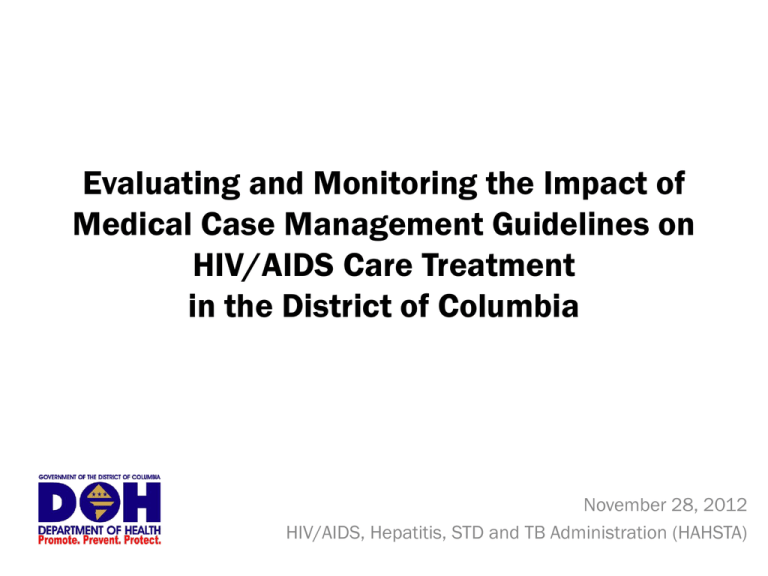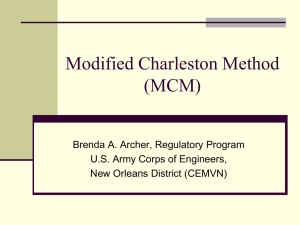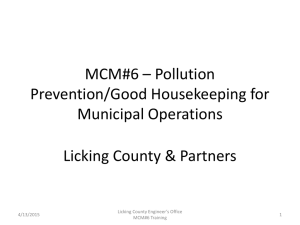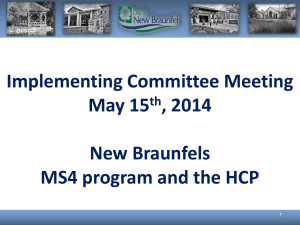HIV Medical Case Management Guidelines Training
advertisement

Evaluating and Monitoring the Impact of Medical Case Management Guidelines on HIV/AIDS Care Treatment in the District of Columbia November 28, 2012 HIV/AIDS, Hepatitis, STD and TB Administration (HAHSTA) Disclosures » This continuing education is managed and accredited by Professional Education Service Group. The information presented in this category represents the opinion of the author(s) or faculty » Neither PESG, nor any accrediting organization endorses any commercial products displayed or mentioned in conjunction with this activity » Commercial support was not received for this activity 2 Disclosures Have no financial interest or relationship to disclose » Christie Olejemeh » Gunther Freehill » Lena Lago » Justin Goforth is a speaker for Merck Pharmaceutical Company 3 Learning Objectives At the conclusion of this session, the participant will be able to: » Identify at least three fundamentals of a quality medical case management program; » Demonstrate importance of client assessment tools and practice hands on techniques; » Recognize the critical role of medical case managers in client’s viral suppression; and » Necessity of a “SMART” approach to developing clientcentered service plans that incorporates treatment adherence techniques. 4 Agenda » » » » » » » DC’s Journey Fundamentals of MCM MCM Operational Model MCM Service Plan Monitoring Evaluation Conclusion 5 District of Columbia’s Journey » Client needs that shaped the pre-MCM system o High burden of HIV/AIDS @ ~3% of DC population >12y.o. o Social services (loss of jobs, housing, and health insurance) o Focus on comfort measures (case management for very sick and dying) » Transition to current system o HRSA redefined case management Medical Case Management Include treatment adherence No standard to follow just directive 6 DC’s Journey: Development Process » HAHSTA’s leadership bought into the HRSA definition and decided to fund only Medical Case Management in the District. » In 2009, HAHSTA convened the case management communities and stakeholders to discuss way forward » Unanimous decision to pursue development of a guidance document for MCM with emphasis on improved health/medical outcomes for clients 7 Timeline » Two workgroups comprised of HAHSTA staff and community stakeholders » Reviewed published best practices, where available » Adapted, modified, and developed tools » Guidelines released in multiple phases 8 MCM Acuity Scale and Guidelines HRSA Directive to Establish MCM Standards Meeting with Key Stakeholders and Providers HAHSTA Conducted Literature Review and Defined Framework for MCM Service Delivery Phase II: Workgroup Convened to Develop Assessment Tools and MCM Guideline Phase I: Developed and Rolled out Acuity Scale Established Internal and External Workgroup Optional Trial Utilization Period, Feedback Mechanis m, and, Ongoing Communic ation with Providers Phase III: MCM Guidelines Launched and Delivered Provider Trainings Training Curriculum Developed 9 Phases Phase I » Four-Level Acuity Scale » “SMART” MCM Service Plan » Released in March 2010 » Trial utilization and feedback period » Conference calls » Revision of tools Phase II » Assessment tools » Supervisor’s Worksheet » Program/Client monitoring and tracking » May 2010 - Full day training for medical case managers in the EMA » June 2010 - Full day training of Treatment Adherence » Feedback period and conference calls » >250 medical case managers in the EMA the two trainings. 10 Challenges and Reservations » Diversity of case management population » Push back from case managers without clinical background » Nurses and social workers who are more suited for job with clinical focus » Fear of losing jobs » Educational qualification (grandfathered case managers) » Case loads per case manager? » Registering MCM (a repository for all trained MCMs?) 11 Agenda » » » » » » » DC’s Journey Fundamentals of MCM MCM Operational Model MCM Service Plan Monitoring Evaluation Conclusion 12 HIV Medical Case Management: Guidelines Overview » Intend to provide guidance for the uniform delivery of highquality HIV Medical Case Management (MCM) with an emphasis on achieving results and improved health outcomes for clients » Reflect the collective experiences of HAHSTA staff and other sources including medical case managers, consumers from community organizations and community supervisors » Do not provide guidance on the law, rules and regulations that define professional MCM practice » Aim to set a minimum level for the quality of MCM services provided in the District of Columbia 13 Fundamentals of HIV Medical Case Management » All MCM programs should specifically address, apply and promote: • • • • • • • • • • • • Access to Primary Medical Care Treatment Promotion Treatment Adherence Linkages and Coordination Health System Navigation Monitoring health outcomes and results Retention and Re-engagement of clients into care Harm reduction Disclosure for social support Standard Operating Procedures Performance Evaluation of Medical Case Managers Professional Development for MCM Staff 14 Fundamentals of HIV Medical Case Management » Access to Primary Medical Care Emphasis on the importance of having a medical home and getting your clients into care. » Treatment Promotion For effective intervention, ensure that clients are engaged in discussions about treatment. Treatment leads to better health. 15 Fundamentals of HIV Medical Case Management » Treatment Adherence An essential element of every MCM program is to incorporate treatment adherence at every level and stage of the process. Encourage readiness and adherence to HIV/AIDS treatments. Special emphasis given to viral load, CD4 count etc. This key component is an ongoing element, changing as the client’s goals and medical condition change. 16 Fundamentals of HIV Medical Case Management » Treatment adherence interventions equip clients with the skills, information and support to follow mutually agreed upon, evidenced-based recommendations to achieve optimal health. » Issues to be addressed: • • • • Taking medications as prescribed Making and keeping appointments Addressing barriers to care and treatment Adapting to therapeutic lifestyle changes as necessary 17 Fundamentals of HIV Medical Case Management » Linkages and Coordination MCM is not a ‘farewell’ program. Actively coordinate direct linkages to needed services and establish a concrete mechanism for feedback. “Linked” services must be received in 30 days. » Health System Navigation Many clients fall out of care because they are overwhelmed with the health care system. MCM programs help to navigate the many loops for clients to ensure they are retained in care. 18 Fundamentals of HIV Medical Case Management » Monitoring Outcomes and Results • MCM should ultimately improve health outcomes and track these improvements at the program and individual level. • Clients on ARV with no improvement in viral load and CD4 count should be discussed with the primary care provider. » Retention and Re-engagement of Clients in/into care • MCM programs should have re-engagement procedures for those lost to care (missed appointments for 6 months or more). • Program goal should be 95% retention of clients. 19 Fundamentals of HIV Medical Case Management » Harm Reduction Core HIV prevention and harm reduction messages should be included in routine contact with clients. Linkages provided to needle exchange programs, partner services, prevention for positives programs. » Disclosure for Social Support MCM programs should support and educate clients on safe disclosure as part of routine services. 20 Fundamentals of HIV Medical Case Management » Standard Operating Procedures MCM programs must have established procedures to be followed in carrying out MCM operations. HAHSTA and the HIV Planning Council developed minimum basic MCM standards to complement the guidelines. • “Care not documented is care not done”. A sample of what to document is included. At every stage of the MCM, some documentation are required and necessary. • Customer service: No prescribed HAHSTA approach but initiative encouraged to ensure client is treated professionally and cordially to ensure clients return for follow-up visits. 21 Fundamentals of HIV Medical Case Management » Performance evaluation of Medical Case Managers • Core activity of an MCM program • With few exceptions, performance is based on the outcomes achieved for the client. Key measures to be used by supervisors are provided. » Professional development for MCM staff • Staff should be supported to acquire skills or develop the abilities necessary to improve performance. All HAHSTA funded MCM program staff must attend CMOC quarterly trainings and treatment adherence roundtables & education training series organized. 22 Agenda » » » » » » » DC’s Journey Fundamentals of MCM MCM Operational Model MCM Service Plan Monitoring Evaluation Conclusion 23 Client Intake Conduct an Assessment to Determine Client Acuity Level 4: Monthly Visits and Weekly Phone Calls Re-Assess Level 4: Client Every 3 Months to Determine Progress The Medical Case Management Operational Model Develop an Appropriate Medical Case Management Plan Based on Acuity Level 3: Visits Every 3 months & Monthly Phone Calls Level 2: Visits Every 6 months & Phone Calls Every 3 months Level 1: Visits Every 6 months A. Reassess Client Every 6 Months to Determine Progress B. Reassess at Key Events Medical and Psycho-social Health Outcome Negative Outcome Positive Outcome 24 Identifying Clients in Crisis » Possible crisis situations requiring immediate attention include: • Suicidal thoughts or actions • Recent discovery or change in HIV status and request for immediate supportive counseling • Domestic violence • Hospital admission required and no child care in place • Child abuse or neglect, unattended young child and/or threats of harm against a child • Primary care provider suspects child abuse/medical neglect • Client faces immediate disruption of HIV-related medications 25 Client Assessment » Systematic gathering of information from and discussion of information with the client » Requires at least one face-to-face conversation and information from secondary data sources » During this time, information about the client should be gathered to inform placement on the acuity scale » Assessment should identify: • • • • • Critical flags/triggers Competing needs (e.g. housing, social services, transport, etc.) Medical conditions Adherence and medication history Current ability to adhere to medication regimen 26 Triggers for Placement in the Intense Management Level on the Acuity Scale » Clients in any of the following situations will automatically be placed in the Intensive Management Level and reassessed in 3 months: • • • • • • • • • Homelessness Peri-incarceration Pregnancy without prenatal care CD4 count below 200 and Viral Load above 400 New diagnosis of HIV Untreated mental illness New to Antiretroviral therapy Not in care/Re-engaging in care Non-adherence to HIV medication 27 MCM Comprehensive Assessment Tool » Designed to help elicit information necessary to assign an Acuity Level to each client » Divided into seven categories: • • • • • • • Access to health care Health status Treatment adherence HIV knowledge Behavioral health Children/Families Environmental Factors 28 Acuity Scale Objective tool used to determine the frequency and intensity of engagement with clients receiving MCM services » Based on a point system that reflects the client’s needs across a broad spectrum of function areas which include medical, behavioral and environmental factors » 25 areas of functioning are used to assess the appropriate level of management » Scale ranges from 1 point (self management) to 4 points (intensive) » Completed at the time of entry into MCM and at routine points throughout the year 29 Acuity Scale Levels Management Point Level Range Health Status/Medical Condition Frequency Level 1: SelfManagement Client is medically stable and is 25-35 able to manage supportive needs without MCM assistance. Face to Face at least once every 6 months for reassessment no phone contact indicated Level 2: Basic Management Client is medically stable and is able to manage supportive 36-60 needs with minimal MCM assistance Face to Face every 6 months with at least one phone contact every 3 months Level 3: Moderate Management Client is at-risk of becoming medically unstable without MCM assistance and support systems 61-84 are not adequate to meet client’s immediate needs without MCM support Level 4: Intensive Management 85100 Client is medically unstable and in need of comprehensive MCM support for medical and supportive needs Face to Face a minimum of every 3 months with at least one phone contact monthly Face to Face at least once a month with phone contacts weekly 30 Agenda » » » » » » » DC’s Journey Fundamentals of MCM MCM Operational Model MCM Service Plan Monitoring Evaluation Conclusion 31 Creating an MCM Service Plan » A client-centered approach is used with active participation of the client » All identified deficiencies are addressed but prioritize needs and develop action plans for at least 3 barriers in order of priority » Treatment adherence issues must be ranked as high priority if identified 32 “SMART” Approach » Action plans/objectives/goals must be SMART: • Specific: Every issue identified needs a specific objective and activities for direct intervention. Issues should not be grouped together • Measurable: Define quantifiable outcomes to enhance tracking results and progress towards achieving the objectives • Achievable/Attainable: Set goals in increments. It will be unattainable to set smoking cessation in a week for a lifelong smoker. • Result-Oriented/Realistic: There must be resources and skills available to support the required task. • Time-limited: Deadlines create the urgency necessary; to prompt action, shorter timeframes and deadlines will ensure that objectives are followed up actively. 33 “SMART” MCM Service Plan Elements » Strategies to optimize adherence » Critical flags of laboratory results and documented viral load and CD4 counts » Action plans for linkages incorporating “feedback loops” » Action plans for acquiring independent living skills or support services . 34 Elements of a “SMART” MCM Service Plan MCM Service Plan » Client name: _____________________________________________________ » Client Address: _____________________________________________________ » Overall Goal: _____________________________________________________ Date Identified Need Short term Goal or Objectives Intervention/ Activity/ Action Review Date or Timeline Persons responsible for action Linkages needed or Outcome of intervention » Date & Signature of client: ____________________________________________ » Date & Signature of Medical Case Manager: _____________________________ » Date and Signature of MCM Supervisor: _________________________________ 35 Sample “SMART” MCM Service Plan Date 10/27/09 Identified Need Medication adherence Short term Goal or Objectives Sara will take her medications as prescribed for the next four weeks (11/27/09) Intervention/ Activity/ Action Review Date or Timeline Persons responsible for action 1)Ask client what strategy may work better/comfortable, document viral load and CD4 count 10/27/09 Ms Doe 10/27/09 MCM 2) Provide HIV education 10/27/09 MCM 10/27/09 MCM 3)Discuss benefits of Medication adherence Linkages needed or Outcome of intervention Completed, CD4 350, Viral Load 100,000 Completed/Reinforce Completed/Reinforce Completed/Reinforce 10/27/09 MCM Completed » Date & Signature of client: ____________________________________________ 10/27/09 MCM Completed 5)Provide » Date & Signature of Medical Case Manager: _____________________________ adherence tool-pill 11/03/09 MCM boxes, alarm clock Spoke with Ms Doe » Date and Signature of MCM Supervisor: _________________________________ 11/03/09, to come in for 4)Discuss risk of non- adherence 6)Fill in pill box for a week’s medication doses filling pill box 11/03/09 MCM & Ms Doe Ms Sara came to agency with pill box 7)Organize weekly check-in calls (Call on 11/03/09) 8)Return to agency for pill box checks and filling 36 Client Name:__________________________________Sara Doe___________________________________________ Client Address:___112 New York Avenue, NE, Washington DC , 20002____________________________________ Overall Goal:________________ To keep Ms. Doe engaged in care and adherent to her medications___________ Date Identified Need 10/27/09 Support system/Disclosure Short term Goal/ Objectives Ms Doe will participate in support group by 11/30/09 to enhance her skill to disclose to support system 2) Ms Doe will be referred to partner services by 11/30/09 to help disclose to partners Intervention/Activiti es/ Actions 1)Provide HIV education Outcome of actions/ Date Review Due/Timeline Persons responsible for action 10/27/09 MCM Linkages Needed Completed 2)Refer and/or enroll in support group 10/27/09 MCM Enrolled 3) Refer to Partner services 10/27/0911/15/09 MCM 10/27/09 MCM Attended group 11/19/09 11/30/09 MCM Partners notified 11/30/09 Enrolled 11/13/09 4) Refer and/or enroll in Healthy relationship program (Prevention for positives group sessions) 5) Follow up on partner notification next appointment 37 Implementation and Monitoring Treatment adherence at every stage using viral load and CD4 count » MCM programs have a responsibility to directly provide or link their clients to treatment adherence services » Adherence support includes interventions or special programs to ensure readiness for, and adherence to, complex HIV/AIDS treatments » MCMs should reinforce treatment adherence at every contact (via phone, face-to-face meetings, etc.) » Client-specific adherence intervention programs help reduce missed doses of medication with the goal of viral load suppression 38 Treatment Adherence Support at Every Client Contact and Stage in the MCM Process Intake » Ask if client is on medication; schedule primary care appointments or ensure existing ones are kept » Ensure client has access to health/drug payer programs - ADAP, Medicare, Medicaid (including temporary demonstration programs such as the HIV 1115 waiver) Assessment » Remember to use the treatment adherence section of the Acuity Scale » Identify and address barriers to treatment adherence » For clients on ARV’s, reinforce adherence MCM Service plan » Develop client-centered strategies to maintain optimal adherence » Communicate with the primary care provider MCM Service Plan Implementation & Client Monitoring Reassessment » Have you asked about viral load and CD4 count? Viral suppression is the goal. » Educate on adherence to avoid resistance and for viral suppression » Use adherence tools to support client » Has the client been out of care or is out of medication? Reestablish access. » Recertify client in any lapsed health/drug payer programs 39 Treatment Adherence Support at Every Client Contact and Stage in the MCM Process MCM Operational Stage Intake Assessment MCM Service Plan Sample questions Types of Intervention See Assessment Tool Reinforce HIV/AIDS education, harm reduction and apply for ADAP and other benefits. Ask if client is on medication. See Assessment Tool During assessment, observe for teachable moments! Stop! Educate and dispel myths! See Service Plan Tool Discuss goal as viral suppression and overall optimal health outcomes. (See sample of treatment adherence service plan in document) 40 Treatment Adherence Support at Every Client Contact and Stage in the MCM Process MCM Operational Stage MCM Service plan implementation and client monitoring Reassessment Sample Questions Types of Intervention See Assessment Tool (phone or face-toface contact) OBTAIN THE LABS!! Communicate with primary care provider, discuss benefits of medication adherence, discuss non-adherence and resistance, refill prescriptions, refill pill boxes, set alarm clocks/reminders, address side effects and make phone calls as needed and/or per acuity level. If necessary, repeat all questions or only those regarding identified barriers (face to face) Remember medications work ONLY when taken! Reinforce! Reinforce all needed interventions!! 41 Implementing and Monitoring an MCM Service Plan » The following elements are needed to effectively implement and monitor an MCM Service Plan: • Full understanding of the issue • An understanding of the goals and objectives • Knowledge of resources, informal and formal linkages and cost/insurance requirements • A relationship with the client • A caring attitude 42 Implementation and Monitoring » MCM responsibilities are, at minimum: • Clearly defining the role of the MCM and the client when arranging for services • Monitoring changes in the client’s condition or circumstances, updating or revising the service plan and providing appropriate interventions and linkage • Monitoring laboratory results to know when to initiate urgent dialogue with the client and the client’s primary care provider if the client is failing a medication regimen and, if needed, devising strategies to optimize adherence. Laboratory results should be reviewed every 3 months to 6 months. • Ensuring the client’s right to privacy and appropriate confidentiality when coordinating services with others 43 Implementation and Monitoring » MCM responsibilities are, at minimum: • Empowering clients to develop and utilize independent living skills and strategies • Assisting clients in resolving any barriers to using and adhering to services; • Actively following up on established goals in the MCM plan to evaluate clients progress and determine appropriateness of services • Maintaining ongoing patient contact according to the Acuity Scale • Actively following up within one business day with clients who have missed a medical case management appointment. In the event that follow-up is not appropriate or cannot be conducted within the prescribed time period, medical case managers will provide justification for the delay. 44 Agenda » » » » » » » DC’s Journey Fundamentals of MCM MCM Operational Model MCM Service Plan Monitoring Evaluation Conclusion 45 Monitoring for Outcomes and Results Monitoring occurs at multiple levels » Client-level » Provider-level » Jurisdictional-level » EMA-wide 46 Client-level Monitoring for Outcomes and Results » Client activity is tracked by type of visit, methods and acuity level to evaluate progress Identified Acuity factors At Intake At Reassessment Newly diagnosed Re-entering care after being out of care for more than 6 months Having a CD4 count below 200 Having a viral load above 400 Non-adherent to HIV medication Management level based on score 47 Client-level Monitoring for Outcomes and Results » Changes in client initial situation and/or acuity level at intake are evaluated at reassessment Date of Visit Type of Visit Method of Visit Acuity Level at Time of Visit Comments 48 Client-level Monitoring for Outcomes and Results » Client laboratory results are monitored to track changes and progress • Primary Care Physician: ______________________________________ • Location: __________________________________________________ Date of Visit Type of visit (primary care, substance abuse, dental, mental health, emergency) CD4 Count Lab Date Viral Load Lab Date Comments/ Results 49 Client-level Monitoring for Outcomes and Results » Client overall medical information is tracked • • • • Is the client currently on ART?: __________________________________ Date Initiated: ________________________________________________ Is client on other medications or prophylaxis?:______________________ Medication Summary:__________________________________________ ART Regimen or Other Prescription Date Initiated Date Stopped Comments on changes 50 Client Measures of Improved Health Outcomes » » » » » » CD4 count Viral load and viral load suppression Missed doses of medication Appointments attended Medication side effects HIV-related hospitalizations or ER visits 51 Provider-level Monitoring Strategies and Tools: Performance Evaluation » MCMs are evaluated on outcomes achieved for clients across the following categories: • Core Performance Areas • • • • • • Needs Assessment Linkages and Coordination Treatment Adherence Support Acuity Management Level Monitoring of Health Outcomes Retention and Re-engagement of Clients • Core Competences • Conducting sensitive and empathetic interviews • Relationship building • Processes and Documentation 52 Provider-level Monitoring Strategies and Tools » » » » » » Chart reviews Direct observation of medical case managers Client satisfaction survey Case conferencing/reviews Monthly meetings Attending mandatory trainings 53 Grantee-level Monitoring Strategies and Tools » Monthly reports: Process measures » Quarterly reports: Outcome measures » Reporting requirements and templates that are consistent with MCM Guidelines and HRSA Performance Measures » Annual report: Client-level / RSR data reviews 54 Grantee-level Monitoring: Indicators for Provider Quarterly Reports, GY2010-2011* Measure Total unduplicated clients served this quarter Number of clients classified as Level 1/Self management Number of clients classified as Level 2/Basic Management Number of clients classified as Level 3/Moderate Management Number of clients classified as Level 4/Intensive Management Unduplicated New clients this quarter Number of clients linked to: Primary Care Mental Health Substance Abuse ADAP Oral Health Housing Number of clients who were suppressed to a viral load level <400 at the time of reporting Number of clients who have CD4 counts over 350 at time of reporting Number of clients receiving treatment adherence counseling as part of their MCM visit *Revised reporting format GY2012 to include HAB measures 55 Agenda » » » » » » » DC’s Journey Fundamentals of MCM MCM Operational Model MCM Service Plan Monitoring Evaluation Conclusion 56 MCM Guidelines: Provider-level Evaluations Quarterly Reports: • Methods - Analysis of MCM Provider Reports for • Rates of VL and CD4 monitoring and treatment adherence provision, Quarter I (March to May) of 2010 and compared to Quarter I of 2011 • Acuity Scale in GY2011 • Linkage and coordination in GY2011 • Limitations – • Aggregate, self-report data; • Number of providers increases substantially in analysis with multiple years; • Adjusted for only clients with reported acuity scale; and • Probability of duplicated client 57 Quarterly Report – VL, CD4, and Tx Adh Evaluation Results Period of Reporting % of Programs Monitoring Viral Load % of Programs Monitoring CD4 Count % of Program providing Treatment Adherence March –May 2010 (n= 9) 42 47 80 March – May 2011 (n=23) 91 87 74 Overall Change ---- 58 Quarterly Report - Acuity Scale Review » Assessment of distribution of MCM client population by acuity level for GY2011 » Categorized by: Self-management / Level 1 Basic-management / Level 2 Moderate-management / Level 3 Intensive-management / Level 4 59 Acuity Scale Breakdown, GY2011 100% 90% 255 264 356 176 179 258 80% 70% 158 139 60% 50% Intensive Management 259 378 468 412 Moderate Management Basic Management 40% Self-Management 30% 20% 327 446 541 451 Q1 Q2 Q3 Q4 10% 0% 60 Quarterly Report – Linkages and Coordination Review » Assessment of referrals and linkages, and coordination of care distribution for GY2011 » Coordination to select Core Medical Services: Primary Care Mental Health Substance Abuse, Outpatient ADAP Oral Health » Coordination to select Support Services: Housing 61 Linkages and Coordination, GY2011 Q4 Primary Care Q3 Mental Health Substance Abuse ADAP Q2 Oral Health Housing Q1 0 500 1000 1500 2000 62 Quarterly Report - Linkages and Coordination Review » Referrals are not enough; MCMs should ensure clients attend appointments and obtain feedback from service providers » Strong linkages include a defined process for information exchange and feedback and a mutually understood method for enrolling clients in services » MCMs are required to coordinate the process of many services and treatments needed by clients 63 Quarterly Reports Review Results » Primary medical care and housing topped the most linked services » Viral load suppression is the most important indicator of for determining if treatment is successful. » There is a significant association between reduction in viral load and improved clinical outcome. » The Medical Case Manager can play a role in flagging an impending treatment failure. » Monitoring health outcomes is key. MCM Guidelines: System-level Evaluations Ryan White Services Report (RSR): • Methods - Compared VL Suppression and CD4 rates from RSR, on the same providers, across Quarter I (March to May) and Quarter II (June to August) in 2010 and 2011 • Limitations – Proportion of clients for which VL and CD4 testing was done; Potential for client population change from year to year 65 RSR – Evaluation Results 80% 70% 60% 50% 40% 30% 20% 10% 0% 2010 - Quarter 1 2010 - Quarter 2 % Suppressed % CD4 >400 2011 - Quarter 1 2011 - Quarter 2 % Treat Adh Visit 66 Capacity Building Activities Quarterly Trainings » In collaboration with Case Management Operation Committee (CMOC), HAHSTA organizes four quarterly trainings yearly » More than 250 medical case managers in the Eligible Metropolitan Area (EMA) have been trained on the effective use of this document. 67 Evaluation – MCM Survey » After two years of full implementation of the MCM Guidelines, HAHSTA evaluated use, effectiveness, training needs, and necessary changes » The survey was administered to the MCM community during a quarterly training. 28 of 80 (35% response rate) MCM in attendance submitted a completed survey. » The survey instrument contained ten sections MCM Survey Sections Section 1: Section 2: Section 3: Section 4: Section 5: Section 6: Section 7: Section 8: Section 9: Section 10: Overall Effectiveness of Guideline Tool Usage and Needed Revisions Acuity Scale Treatment Adherence MCM Service Plan Reassessment Documentation Performance Evaluation Training Needs Educational levels 69 MCM Survey – Effectiveness of Guidelines % Overall Effectiveness Intake procedures 96 Client assessment 96 Use of acuity scale 92 MCM service plan 92 Eligibility verification 88 MCM service plan implementation and monitoring 88 Reassessment 85 Documentation 83 Performance evaluation 77 Discharge / closeout 68 Supervisor’s worksheet 68 CDQ tool 65 92% of the respondents rated the guideline to be effective in providing medical case management service 70 MCM Survey – Usage of the Tools » Respondents rated usage of tools as “Yes”, “Somewhat”, “No” or “Not Applicable” » In this analysis, “Yes” and “Somewhat” were combined. Results » Highest rate of usage » MCM Service Plan Template at 90%, » Comprehensive Assessment Form at 88% » Lowest usage is Supervisor Worksheet at 40% 71 MCM Survey – Needed Revisions » Resounding “NO” need to revise: o The MCM Service Plan o Mini-Mental State Exam » Comprehensive Assessment Form (used by 88% of respondents) revision requested at 59% » Mixed responses on the need to revise other tools » Workgroup will be formed to work on updating the Guideline Tools 72 MCM Survey – Treatment Adherence Effectiveness Treatment Adherence Activities: Education of the basics of HIV disease Use of adherence aid/tool Knowledge of HIV medications Treatment adherence support Medication side effects and management Treatment adherence assessment questions Knowledge of laboratory results and significance Medical provider communication Case conferencing with interdisciplinary team % Good and Excellent 100 100 100 100 95 91 86 86 83 Information used to measure clients’ improved health outcomes - 88% of respondents correctly identified decreased viral load and increased CD4 count 73 Qualitative Feedback » Medical Case Managers who had no clinical background were very apprehensive when clinical outcomes were introduced into the guideline. » However, since the guideline, many MCMs have acquired knowledge and are agents of change in using clinical outcomes to champion the cause of change for their client. » They have been trained in » Understanding laboratory results, » Communicating with primary care provider and receiving laboratory results from big organizations. » Medication side effects and its use as intervention in adherence activities have increased. » Some providers incorporated guideline tools into electronic medical records 74 Moving Forward » Revised reporting measures and format » Multi-year comparative analysis » Management Information System advancements to allow for verification of aggregate data reports 75 Current Quarterly Measures MCM: Medical Visits MCM: Viral Load Monitoring MCM: Viral Load Suppression on ART MCM: PCP Prophylaxis MCM: Syphilis Screening MCM: Oral Exam / Dental Visit MCM: Care Plan MCM: Adherence Assessment/Counseling 76 Agenda » » » » » » » DC’s Journey Fundamentals of MCM MCM Operational Model MCM Service Plan Monitoring Evaluation Conclusion 77 Lessons Learned » Community involvement from onset created a sense of ownership facilitating grantee implementation » Gradual release of document over a 1-year period helped reduce apprehension among providers » Medical case managers without clinical background can be and were empowered to track positive clinical outcome for clients » Providers in non-clinical settings realized their relevance even in a medically focused environment » Training was vital to effective information dissemination 78 Conclusion » 100% of providers have implemented the MCM guidelines » MCM is effective in assessing client needs and ensuring access to quality services » Guidelines provided basis for evaluating effectiveness of MCM services » Clients are assessed into MCM levels which corresponds to intensity of interventions » Linkage to Primary Care was significantly higher » Some providers have built guidelines into electronic medical records and management information systems which ensures access of standardized reports to all providers in same organization for better coordination of care. 79 MCM On-line Resources http://doh.dc.gov/node/320792 80 Post-Training Exam Please complete the brief post -training assessment being passed out at this time. . Obtaining CME/CE Credit If you would like to receive continuing education credit for this activity, please visit: http://www.pesgce.com/RyanWhite2012 Contact Information » Christie Olejemeh - christie.olejemeh@dc.gov » Gunther Freehill - gunther.freehill@dc.gov » Justin Goforth - jgoforth@whitman-walker.org » Lena Lago - lena.lago@dc.gov 83







